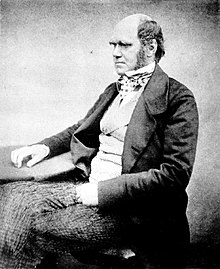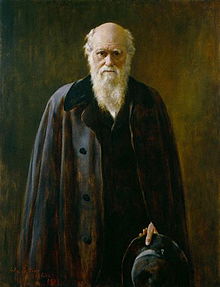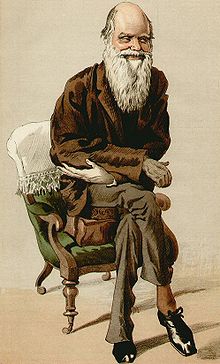Charles Darwin
![]()
Darwin is a redirect to this article. For the physicist of the same name, see Charles Galton Darwin; for other meanings, see Darwin (disambiguation).

Charles Robert Darwin [tʃɑrlz 'dɑː.wɪn] (* 12 February 1809 in Shrewsbury; † 19 April 1882 in Down House/County of Kent) was a British naturalist. He is considered one of the most important natural scientists because of his major contributions to the theory of evolution.
The second voyage with the HMS Beagle, which began at the end of 1831 and lasted almost five years and took the young Darwin once around the world, was both a key experience and the basis for his later work. Darwin first became known to the general public through his travelogue, published in 1839. With his theory on the origin of coral reefs and other geological writings, he gained recognition in scientific circles as a geologist. His studies on the barnacles (Cirripedia) also earned him a reputation as a respected zoologist and taxonomist in the mid-1850s.
As early as 1838, Darwin devised his theory of adaptation to habitat through variation and natural selection, explaining the phylogenetic development of all organisms and their division into different species. He spent over 20 years gathering evidence for this theory. In 1842 and 1844 Darwin wrote brief outlines of his theory, but he did not publish them. From 1856 he worked on an extensive manuscript entitled Natural Selection. Through a letter from Alfred Russel Wallace, which contained his Ternate manuscript with similar thoughts on evolution, both finally published their theories on evolution in the summer of 1858. This was followed a year later by Darwin's magnum opus On the Origin of Species, which, as a strictly scientific explanation for the diversity of life, forms the basis of modern evolutionary biology and represents a decisive turning point in the history of modern biology.
In 1871, in The Descent of Man, and Selection in Relation to Sex, Darwin discussed a second selection mechanism in the form of sexual selection and used his theory to explain human descent. In the last decade of his life, Darwin studied climbing plants, orchids, and carnivorous plants and made important contributions to botany. His official botanical author code is "Darwin".

Darwin at the age of 51 (photograph). Around this age he published his theory of evolution.

Darwin shortly before his death. Painting by John Collier
Reception and aftermath
Charles Darwin is considered one of the most important natural scientists of all due to his significant contributions to the theory of evolution and is still strongly present in the public consciousness due to this achievement. In 1992, for example, Darwin was ranked 16th in a list of the most influential people in history, and in Great Britain he was voted fourth in the 100 Greatest Britons.
Today, the theory of evolution, founded by Darwin and continuously developed since then, represents the fundamental paradigm for biology: Through it, all biological sub-disciplines, such as zoology, botany, behavioral science, embryology, and genetics, are gathered "under one unified roof." Theodosius Dobzhansky formulated this succinctly in 1973 in the oft-quoted phrase: "Nothing in biology makes sense except in the light of evolution."
Darwin's works, first and foremost Origin of Species and Descent of Man, triggered a flood of reviews and reactions shortly after their publication. Darwin's theories not only touched on biological issues, they also had "far-reaching implications for theology, philosophy and other humanities, as well as for the political and social spheres". Darwin's theories were discussed not only in scientific circles but also by the clergy and the general public. Topics included the problem of teleology, the role of a creator, the mind-body problem, and man's place in nature. That man is not an independent creation, but a product of evolution like millions of other species, contradicts Christian doctrine as well as many philosophical schools. Sigmund Freud called the theory of evolution one of the three mortifications of mankind's self-love.
Important parts of his theory had quickly gained acceptance: the fact of evolution itself and common descent. The mechanism of selection, however, remained controversial for a long time and only one of several mechanisms discussed. At the first major jubilee celebrating Darwin's 100th birthday in 1909, there was almost no one to support the selection theory. This period was later called the "eclipse of Darwinism" by Julian Huxley. It was not until the synthetic theory of evolution, also known as the second Darwinian revolution, that the theory of selection also achieved a breakthrough. In the 20th century, under Darwin's influence, new disciplines emerged such as behavioral science and sociobiology, whose application to humans is discussed in philosophy as "evolutionary ethics". Evolutionary epistemology ultimately traces its origins to Darwin, and important elements of evolutionary economics were influenced by his work.
Darwin's theories were misinterpreted and transferred into the political sphere in the ideology of Social Darwinism. This transposition, based among other things on a naturalistic fallacy, can neither necessarily be derived from Darwin's work, nor does it remotely correspond to Darwin's view of the world and man.
"No other 19th-century scientist has had a greater influence on our modern view of the world - both in biology and beyond it - than this English explorer."

"Natural Selection": Caricature by Carlo Pellegrini in Vanity Fair magazine, September 30, 1871.
Honors
Among the species named after Darwin are the Darwin finches, the Eocene primate genus Darwinius, and the nasal frog Rhinoderma darwinii. Also, the following geographic locations: Charles Darwin National Park (Australia), Charles Darwin University (Australia), Darwin College in Cambridge (England), Darwin (Falkland Islands), Darwin (Australia), Darwin Glacier and Mount Darwin (California), Isla Darwin, Darwin Island (Antarctica), Darwin Sound (Canada), Darwin Sound (Tierra del Fuego), Monte Darwin (Tierra del Fuego), Mount Darwin (Tasmania), Cordillera Darwin (Chile), and Cape Darwin (East Antarctica).
The asteroid (1991) Darwin, the lunar crater Darwin and a Martian crater are also named after him.
In 2012, Rostock Zoo opened the Darwineum, a mixture of zoo and museum, in which evolution is explained.
Questions and Answers
Q: Who was Charles Robert Darwin?
A: Charles Robert Darwin was an English naturalist who was born in Shrewsbury, Shropshire. He is famous for his work on the theory of evolution.
Q: What book did he publish?
A: Darwin published a book called On the Origin of Species in 1859.
Q: What evidence did he put forward to support evolution?
A: In his book, Darwin put forward much evidence that evolution had occurred and proposed natural selection as the way evolution had taken place.
Q: Was Darwin aware of genetics?
A: No, Darwin never read the work of Gregor Mendel and so he was not aware of genetics when proposing his theory of evolution.
Q: How did Darwin explain why giraffes have long necks?
A: According to Lamarck's idea, giraffes' necks became longer because those with longer necks survived better and passed their genes on, resulting in the whole species getting longer necks over time.
Q: Was Lamarck's explanation correct?
A: No, although Lamarck's explanation was similar to what we now know about genetics and evolution, it was fundamentally incorrect compared to what we understand today due to advances in science since then.
Search within the encyclopedia